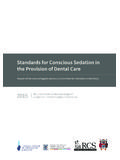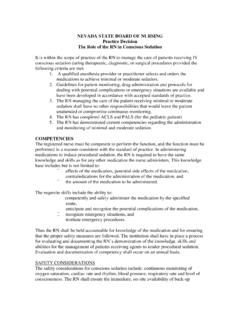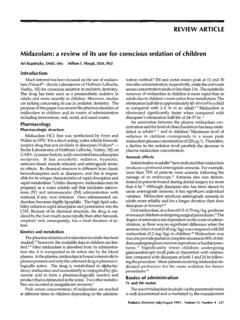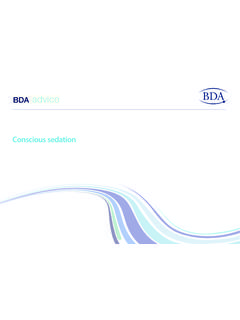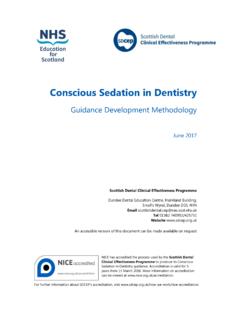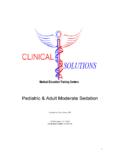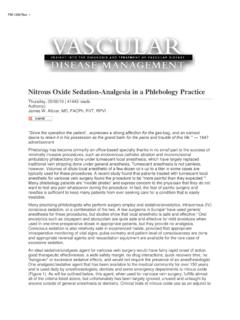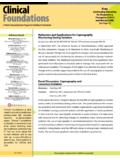Transcription of MODERATE SEDATION MODULE - EduTracker
1 1100 S. Van Dyke Bad Axe, Michigan 48413 989-269-9521 Fax: 989-269-7948 MODERATE SEDATION MODULEMODERATE SEDATION MODULEMODERATE SEDATION MODULE IntroductionIntroductionIntroduction The purpose of this program is to provide the professional nurse with information necessary to safely and appro-priately care for a patient receiving MODERATE / conscious SEDATION within the healthcare setting. These settings usually have policies set forth to help guide nursing staff who cares for the patient receiving and recovering from MODERATE SEDATION . For Example, Huron Medical Center s policy is called Guidelines for Moder-ate SEDATION for Short Term Therapeutic, Diagnostic, or Surgical Procedures ( ). Such resources often address the administration and care of patients receiving MODERATE ( conscious ) SEDATION , including definitions of levels of SEDATION and monitoring requirements.
2 MODERATE SEDATION will be administered under the direction of a credential physician performing the procedure and by a competency validated RN. The physician must have been granted MODERATE SEDATION privileges by the Huron Medical staff credentialing committee. At many hospitals, all MODERATE SEDATION is overseen by the Anesthesia Department. Forms are created to help ensure documentation meets MODERATE SEDATION policy guidelines. Please refer to the MODERATE SEDATION Record in your department for proper documentation. Please understand that frequent administration of MODERATE SEDATION / conscious SEDATION does not necessarily guarantee competency. Staff may be educated in MODERATE / conscious SEDATION but perform the procedure infrequently, with the possibility of long periods between procedures.
3 Regardless of SEDATION administration, all individuals performing SEDATION must meet the same standards ( ACLS and PALS certification, etc.). To obtain a list of physicians credentialed in conscious / MODERATE SEDATION , you may refer to HMC s Intranet. Objectives Objectives Objectives After completion of this MODULE , the learner will be able to: Identify the difference between MODERATE / conscious SEDATION and deep SEDATION . Identify the purpose of MODERATE / conscious SEDATION . Identify the elements required for pre- SEDATION , intra-procedure, and post SEDATION assessment. Identify discharge criteria for patients who have received MODERATE SEDATION . Discuss common adverse reactions related to drugs used in MODERATE SEDATION . Identify the signs of respiratory depression and airway compromise.
4 Articulate the elements of airway management during MODERATE / conscious SEDATION . Identify emergency situations arising from MODERATE / conscious SEDATION . As you complete this MODULE and the accompanying test, feel free to seek clarification from other sources as needed; such as a medication book, your Department Director, and hospital policies. This MODULE , objectives, and test were authored/prepared by Mary Aymen, CRNA, in conjunction with Huron Medical Center s Community Outreach/Hospital Education Department. Additional contributor: Dr. Naeem Haider, MODERATE SEDATION & Analgesia MODERATE SEDATION & Analgesia MODERATE SEDATION & Analgesia Definition: MODERATE SEDATION /analgesia is a drug-induced depression of consciousness during which patients retain the ability to independently and continuously maintain a patent airway; as well as respond appropriately to verbal and/or light tactile stimulation.
5 The Continuum of SEDATION :The Continuum of SEDATION :The Continuum of SEDATION : Practitioners intending to produce a level of SEDATION should be able to rescue patients whose level of SEDATION becomes deeper than initially intended. Levels of SedationLevels of SedationLevels of SEDATION Minimal SEDATION is a drug-induced state during which patients respond normally to verbal commands (note: reflex withdrawal from painful stimulus is not considered a purposeful response.) Although cognitive function and coordi-nation may be impaired, ventilatory and cardiovascular functions are unaffected. Pg 1 No SEDATION Minimal SEDATION MODERATE SEDATION Deep SEDATION Anesthesia Because SEDATION is a continuum, it is not always possible to predict how a particular patient will respond MODERATE SEDATION /Analgesia (Formerly referred to as conscious SEDATION ) is a drug-induced depression of con-sciousness during which patients respond purposefully to verbal commands, either alone or accompanied by light tac-tile stimulation.
6 No interventions are required to maintain a patent airway and spontaneous ventilation may be ade-quate. Cardiovascular function is usually maintained. Deep SEDATION /Analgesia is a drug-induced depression of consciousness during which patients cannot be easily aroused, but respond purposefully following repeated or painful stimulation. The ability to independently maintain ventilatory function may be impaired. Patients may require assistance maintaining a patent airway and spontaneous ventilation may be inadequate. Cardiovascular function is usually maintained. Anesthesia consists of general anesthesia, spinal, or major regional anesthesia. It does not include local anesthesia. General anesthesia is a drug-induced loss of consciousness during which patients are not arousable even by painful stimulation. The ability to independently maintain ventilatory function is often impaired.
7 Patients often require assis-tance in maintaining a patent airway, and positive pressure ventilation may be required because of depressed sponta-neous ventilation or drug-induced depression of neuromuscular function. Cardiovascular function may be impaired. MODERATE SEDATION : What it s not: Pre-Medication: -Defined as a single dose prior to a medication -Medication is not TITRATED to effect as in MODERATE SEDATION Post-Operative Pain Management: -Given for post op pain, Including PCA -Medication is not TITRATED to effect as In MODERATE SEDATION Goals of MODERATE SEDATION Alteration of LOC and mood Maintenance of consciousness and cooperation Elevation of pain threshold Minimal variation of vital signs Rapid degree of ambulation Safe and prompt recovery MODERATE SEDATION should result in: A patient that is relaxed & cooperative with.
8 -Purposeful responses to verbal communication and instruction -Purposeful responses to tactile stimulation -Easy and prompt arousal from sleep Pg 2 Physicians Physicians Physicians Physicians must be granted clinical privileges for MODERATE SEDATION procedures by the Huron Medical Staff Credentialing Committee. Elements of physician responsibilities include: Perform a pre- SEDATION patient assessment and document properly on the chart Develop a SEDATION plan and obtain informed consent Be present during the administration of the drug, duration of the procedure, as well as during immediate post- operative stage until the patient is medically stable Equipment and SuppliesEquipment and SuppliesEquipment and Supplies Each designated area where SEDATION is administered must have emergency resuscitative equipment immediately available - equivalent to that used in other areas of the hospital, and which is checked and maintained on a scheduled basis.
9 All Emergency equipment must be able to accommodate patients of any size or age undergoing procedures in that area. Appropriate equipment for patient care and resuscitation will include: Emergency cart Suction device/suction catheters Emergency drugs Oxygen source Defibrillator Nasal O2 cannulas/O2 masks EKG monitor Intubation equipment Blood pressure monitor Positive pressure oxygen delivery Stethoscope device (bag-valve mask) Pulse oximeter IV supplies Appropriate airways CO2 detector Pg 3 Personnel Qualifications Personnel Qualifications Personnel Qualifications MODERATE sedations will be administered under the direction of a credentialed physician performing the procedure, and by a registered nurse who has been deemed competent through the hospital s competency assessment and validation process to monitor and manage the care of sedated patients.
10 Assessment of competency is intended to assure that the RN: Understands the principles of oxygen delivery and respiratory physiology Understands the action, side effects and potential complications of the most commonly prescribed sedatives and their antidotes Identify abnormal and life threatening cardiac rhythms Demonstrates skill in airway management and resuscitation Is able to utilize emergency equipment and effectively intervene in the event of complications or undesired outcomes Can assess total patient care requirements during SEDATION and recovery If performing SEDATION on a patient, one must demonstrate competency through ACLS (adult patient) and PALS (pediatric patient) in airway management and resuscitation appropriate to patient age PrePrePre---Procedure Patient AssessmentProcedure Patient AssessmentProcedure Patient Assessment Patient selection for MODERATE SEDATION is based on many factors.





